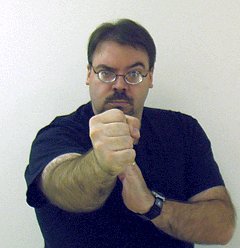its paid sponsors, whose products you need!
“Stay ‘unreasonable.’ If you
don’t like the solutions [available to you], come up with your
own.”
Dan Webre
The Martialist does not
constitute legal advice. It is for ENTERTAINMENT
PURPOSES ONLY.
Copyright © 2003-2004 Phil Elmore, all rights
reserved.
What Is the One-Inch Punch?
By Phil Elmore
Warning: Do not
attempt exercises like the following before consulting your physician!
The
Martialist is not responsible for injury incurred while training and cannot advocate
the use of specific training drills.
 A lot of people associate the one-inch punch with Bruce Lee, but it’s actually a technique from
A lot of people associate the one-inch punch with Bruce Lee, but it’s actually a technique from
Wing Chun.
The one-inch punch is a function of structure of learning to align your body’s “gates” for maximum strength on the punching side. The leg, hip, and arm line up in a specific manner to take advantage of the body’s mechanics in imparting power to the target.
A typical one-inch punch drill starts with students pressing their vertical fists against a wall or other immovable object. The right knee bends and the right hip comes forward as the body twists sharply into the punch. The left leg stays fairly straight (though if you try this you’ll see you can’t help but bend it a little). When the students start pushing themselves away from the wall and feel discomfort in their hands, they know they’re doing it right.
Moving on, the students strike focus pads held by other students. A third student stands behind the punching pair to stop the pad-holder from falling backward. Tremendous power is generated by such punches, both in “pushing power” and “impact power” techniques.
The first time I did this drill in Wing Chun, my pad-holder was a very tall, thin young fellow. I am the heaviest student in class, easily outweighing my instructor by a hundred pounds. Even doing the drill with imperfect mechanics, you must understand that the majority of your weight is on the punching side (where it should be).
I sent the young man flying backwards quite spectacularly so much so that he switched with someone heavier the next time it was my turn. This wasn’t because I’m some ham-fisted gorilla (though the charge has been made) but because of the
structure with which the punch is performed.
We do another relevant drill in Wing Chun a footwork drill called the “shifting horse.” This looks a lot like walking: as the left foot comes forward at an angle, the body shifts on the right heel as the right fist comes forward in a punch. Then the right foot comes forward as the left foot shifts on the heel and the left fist comes
forward in a punch. This helps develop Wing Chun punching.
With practice, the one- and no-inch punches can be done relatively instinctively. If you learn to punch with your body aligned a certain way, after all, that’s how you’ll do it.
If you see benefit in
punching powerfully, it is a very useful technique.
